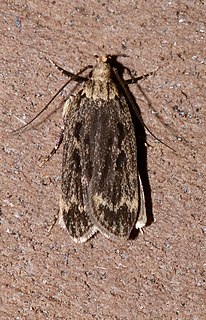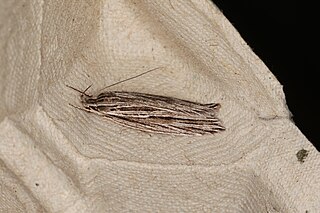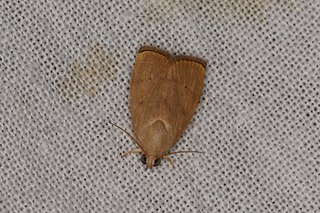Related Research Articles
Parelictis is a monotypic moth genus in the subfamily Arctiinae. Its only species, Parelictis saleuta, the mottled footman, has been recorded from the Australian states of New South Wales and Victoria. Both the genus and species were first described by Edward Meyrick in 1886.

Cosmopterix is a large genus of moth in the family Cosmopterigidae.
Acridotarsa is a genus of moths belonging to the family Tineidae. The genus was described by Edward Meyrick in 1893.

Pyroderces aellotricha, also known as the Cosmet moth, is a moth of the family Cosmopterigidae. It is found in New Zealand, in Australia and the Cook Islands.

Xyloryctidae is a family of moths contained within the superfamily Gelechioidea described by Edward Meyrick in 1890. Most genera are found in the Indo-Australian region. While many of these moths are tiny, some members of the family grow to a wingspan of up to 66 mm, making them giants among the micromoths.
Ardozyga stratifera, the striped ardozyga moth, is a species of moth in the family Gelechiidae. It was described by Edward Meyrick in 1904. It is found in Australia, where it has been recorded from Queensland, New South Wales, Victoria, Tasmania, South Australia and Western Australia.
Megacraspedus ischnota is a moth of the family Gelechiidae. It was described by Edward Meyrick in 1904. It is found in Australia, where it has been recorded from Western Australia.
Macrenches eurybatis is a moth of the family Gelechiidae. It was described by Edward Meyrick in 1904. It is found in Australia, where it has been recorded from Western Australia, the Northern Territory, Queensland and New South Wales.

Martyringa xeraula, the Himalayan grain moth, is a moth in the family Lecithoceridae. It was described by Edward Meyrick in 1910. It is found in India (Assam), western China, Japan and North America, where it has been recorded from Louisiana, Texas and from Florida to South Carolina.
Echiomima fabulosa is a moth in the family Xyloryctidae. It was described by Edward Meyrick in 1915. It is found in Australia, where it has been recorded from Queensland.

Leistarcha amphigramma is a moth in the family Xyloryctidae. It was described by Edward Meyrick in 1915. It is found in Australia, where it has been recorded from the Australian Capital Territory and New South Wales.
Lichenaula lithina is a moth in the family Xyloryctidae. It was described by Edward Meyrick in 1890. It is found in Australia, where it has been recorded from New South Wales.
Lichenaula musica is a moth in the family Xyloryctidae. It was described by Edward Meyrick in 1890. It is found in Australia, where it has been recorded from South Australia, Victoria and Western Australia.
Maroga sericodes is a moth in the family Xyloryctidae. It was described by Edward Meyrick in 1915. It is found in Australia, where it has been recorded from Queensland.
Maroga setiotricha is a moth in the family Xyloryctidae. It was described by Edward Meyrick in 1890. It is found in Australia, where it has been recorded from the Northern Territory, Queensland and Western Australia.
Xylorycta maeandria is a moth in the family Xyloryctidae. It was described by Edward Meyrick in 1915. It is found in Australia, where it has been recorded from New South Wales.
Loboptila cyphoma is a moth in the family Depressariidae. It was described by Edward Meyrick in 1915. It is found in Australia, where it has been recorded from Queensland.

Imma tetrascia is a moth in the family Immidae. It was described by Edward Meyrick in 1912. It is found in Australia, where it has been recorded from Queensland and Western Australia.
Imma vaticina is a moth in the family Immidae. It was described by Edward Meyrick in 1912. It is found in Australia, where it has been recorded from Queensland.

Tingena maranta is a species of moth in the family Oecophoridae. It is endemic to New Zealand and is found in the lower South Island. Adults of this species are on the wing from October until January. This species perfers grass or low herb habitat. Unlike its close relatives it does not inhabit native forest.
References
- ↑ Savela, Markku, ed. (14 December 2013). "Liparistis lioxera Meyrick, 1915". Lepidoptera and Some Other Life Forms. Retrieved 6 September 2020.
- ↑ McMillan, Ian (9 July 2010). "Liparistis". Xyloryctine Moths of Australia. Retrieved 6 September 2020.
 This article incorporates text from this source, which is in the public domain .
This article incorporates text from this source, which is in the public domain .